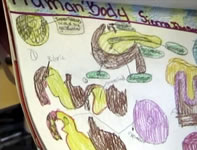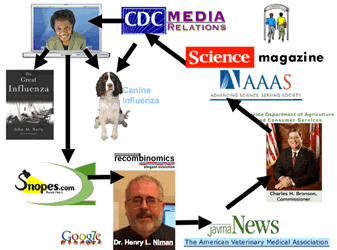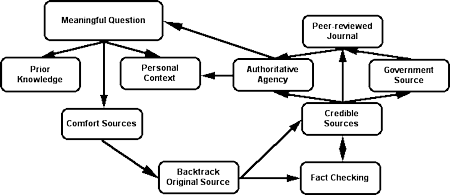 Metacognition
Metacognition
Metacognition involves awareness and knowledge of one's own thinking including knowledge of strategy, task, and person variables (Flavell). According to Pintrich, metacognition involves both metacognitive knowledge and control.
Metacognitive knowledge includes understanding general strategies that might be used for different tasks, knowledge of the conditions under which these strategies might be used, knowledge of the extent to which the strategies are effective, and knowledge of self.
Metacognitive control and self-regulation are cognitive processes that learners use to monitor, control, and regulate their cognition and learning.
Pintrich has identified three types of metacognitive knowledge:
- Strategic knowledge - knowledge of general strategies for learning, thinking, and problem solving.
- Knowledge about cognitive tasks - knowledge that different tasks can be more or less difficult and may require different cognitive strategies
- Self-knowledge - knowledge of one's strengths and weaknesses
Metacognitive Maps
 Today's information explorer faces the daunting task of selecting relevant, meaningful topics to investigate, identifying timely resources, maneuvering through data sources, evaluating the accuracy of sources, synthesizing information, and drawing conclusions with constantly changing information. Illustrating how to move from a question to relevant resources can be a powerful way to show how choices are made to accept, confirm or reject information. Annette Lamb, professor of online course development at Indiana University, shows how one teen’s information inquiry process can be illustrated (Click to enlarge the figure below). Like most teens, Jamal communicates with family members through email. When he receives an email "forward" from him grandmother in Florida, he generally puts it in the trash. She sends lots of "forwarded messages" including chain emails, prayers, political jokes, and urban legends. While she thinks of these messages as fact, Jamal is much more skeptical. He's also mature enough not to argue with grandma. However one email forward catches his eye. The headline is "The New Canine Influenza". The message indicates that a virus deadly to dogs was first found in greyhound race dogs and has been spreading in the canine population of the U.S. He wonders if this could be true. His grandmother is clearly concerned about Bailey, the family dog.
Today's information explorer faces the daunting task of selecting relevant, meaningful topics to investigate, identifying timely resources, maneuvering through data sources, evaluating the accuracy of sources, synthesizing information, and drawing conclusions with constantly changing information. Illustrating how to move from a question to relevant resources can be a powerful way to show how choices are made to accept, confirm or reject information. Annette Lamb, professor of online course development at Indiana University, shows how one teen’s information inquiry process can be illustrated (Click to enlarge the figure below). Like most teens, Jamal communicates with family members through email. When he receives an email "forward" from him grandmother in Florida, he generally puts it in the trash. She sends lots of "forwarded messages" including chain emails, prayers, political jokes, and urban legends. While she thinks of these messages as fact, Jamal is much more skeptical. He's also mature enough not to argue with grandma. However one email forward catches his eye. The headline is "The New Canine Influenza". The message indicates that a virus deadly to dogs was first found in greyhound race dogs and has been spreading in the canine population of the U.S. He wonders if this could be true. His grandmother is clearly concerned about Bailey, the family dog.
Having recently read The Great Influenza: The Epic Story of the 1918 Pandemic by John M. Barry for a science class, Jamal considers whether this could be connected to other recent viruses such as the "bird flu." Like most teens, Jamal spends lots of time on the Internet. His first stop is Snopes (http://snopes.com) to look up dog flu. He quickly locates a copy of the ominous email and is shocked to find that Snopes indicates the email is True. After reading the background information found by Snopes, he decides to conduct his own investigation to confirm the information in the email.
The message refers to an article at Recombinomics.com, so he checks the reference. Wondering about the credibility of this website, he examines the Founder page and learns that the website is authored by a person with authority. To check his credentials, Jamal googles "Henry L Niman". He finds that Niman is being interviewed by many news and health organizations worldwide on this topic.
The article also mentions AVMA. Googling AVMA brings up the American Veterinary Medical Association. This website contains the JAVMA (Journal of Veterinary Medical Association) News which links to an article titled "Canine influenza virus emerges in Florida." It states "Known as canine influenza or canine flu, the disease is caused by a highly contagious virus that was recently identified by researchers at the University of Florida College of Veterinary Medicine." Jamal decides to read the press report from the Florida Agriculture and Consumer Services Commissioner titled Bronson Alerts Public to Newly Emerging Canine Flu. The article indicates that the actual report is in the journal Science (30 September 2005). Unfortunately he doesn't have access to the journal Science, so he logs into his school library to search for the article. He finds that the current issue isn't available online, but it is available in the physical library.
Jamal goes to the journal Science online and wonders about their credibility. The copyright notice indicates the magazine is published by the American Association for the Advancement of Science. The AAAS website confirms that this organization is actually associated with this magazine. He has confidence in this source. The email also mentions the APHIS. He googles APHIS and learns that it's the Animal and Plant Health Inspection Service of the USDA. The website isn't well organized, so he leaves. Finally, he checks the references provided at the Snopes website from the New York Times and Boston Herald. Satisfied that people are concerned about this topic, Jamal decides to see what government officials are doing to address this concern. Having gone to the CDC (Center for Disease Control) as part of his 1918 Pandemic report, he starts there.
Jamal reads a transcript from a news briefing held September 26, 2005. Now we're getting somewhere. The conference includes the author of the article, Dr. Crawford from the University of Florida along with people from the CDC and Cornell. The discussion conveys the idea that the flu is a concern, but that the illness has a low mortality rate. The lead researcher even indicates that she would continue to show her dogs at Kennel Club events and is confident that they'll be fine. This makes Jamal feel much better. Jamal emails his grandmother to assure her that Bailey will be fine.
To be effective in a digital world, teachers as well as students must become metacognitive explorers. The visual below represents Jamal's inquiry process. He is asked to not only create a visual journal of his experience, but also reflect on the skills and sources used during the inquiry process. When Jamal’s experience illustrated in the visual map (Figure 1 above) is matched to his key experiences and sources (Click to enlarge the figure below), it’s possible to trace Jamal’s thinking and use of resources. Notice that he begins with a meaningful question that is associated with prior knowledge and personal context. He begins his exploration with a “comfort source” that he has used successfully in the past. His experience with email-based urban legends leads him to the popular Snopes.com website. Once he has confirmed that the Canine influenza is based on fact, Jamal begins to look for linkages that will lead back to the original source. This involves backtracking to the original source of the email message and checking facts using credible sources such as a well-known organization, a government source, a peer-reviewed journal, and an authoritative agency. Finally, Jamal is able to answer his original question and create a fact-based communication back to his grandmother.
![]() Read Key Word: Metacognition in THE BLUE BOOK by Callison and Preddy, 435-436.
Read Key Word: Metacognition in THE BLUE BOOK by Callison and Preddy, 435-436.


